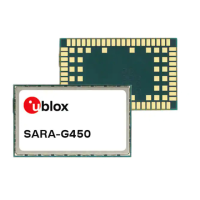SARA-G450 - System integration manual
UBX-18046432 - R08 System description Page 16 of 143
C1-Public
1.5.1.1 VCC supply requirements
Table 6 summarizes the requirements for the VCC module supply. See section 2.2.1 for all the
suggestions to properly design a VCC supply circuit compliant to the requirements listed in Table 6.
⚠ VCC supply circuit design may affect the RF compliance of the device integrating SARA-G450
modules with applicable required certification schemes as well as antenna circuit design.
Compliance is not guaranteed if the VCC requirements summarized in the Table 6 are not fulfilled.
Within VCC normal operating range:
3.4 V min / 4.2 V max
The VCC voltage value must be within the normal
operating range limits to switch on the module.
RF performances may be affected when VCC
voltage is outside the normal operating range
limits.
VCC voltage during
normal operation
Within VCC extended operating range:
3.1 V min / 4.5 V max
The module may switch off when VCC voltage
drops below the extended operating range
minimum limit.
Operation above extended operating range limit is
not recommended and may affect device
reliability.
Support with adequate margin the highest
averaged VCC current consumption value in
connected mode conditions specified in the
SARA-G450 data sheet [1].
The highest averaged VCC current consumption
can be greater than the specified value according
to the actual antenna mismatching, temperature
and VCC voltage. See section 1.5.1.2 for 2G
connected mode current profiles.
Support with margin the highest peak VCC
current consumption value specified in the
SARA-G450 data sheet [1].
The specified highest peak of VCC current
consumption occurs during GSM single transmit
slot in 850/900 MHz connected mode, in the
event of a mismatched antenna. See section
1.5.1.2 for 2G connected mode current profiles.
VCC voltage drop
during 2G Tx slots
VCC voltage drop directly affects the RF
compliance with applicable certification schemes.
Figure 5 describes VCC voltage drop during Tx
slots.
VCC voltage ripple
during 2G Tx
Noise in the supply must be minimized
VCC voltage ripple directly affects the RF
compliance with applicable certification schemes.
Figure 5 describes VCC voltage ripple during Tx
slots.
VCC
under/over-shoot at
start/end of Tx slots
Absent or at least minimized
VCC under/over-shoot directly affects the RF
compliance with applicable certification schemes.
Figure 5 describes VCC voltage under/over-shoot.
Table 6: Summary of VCC supply requirements

